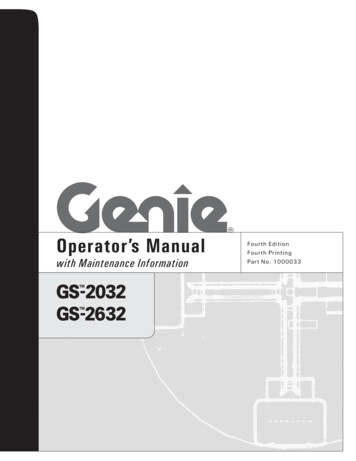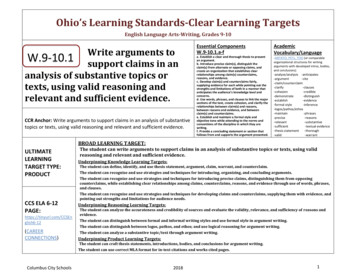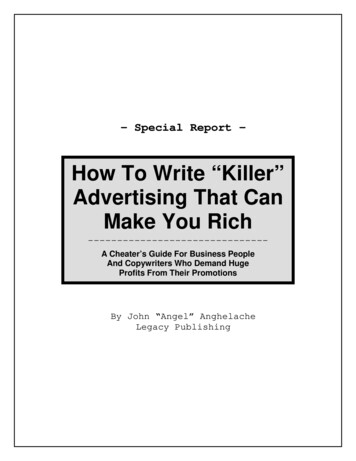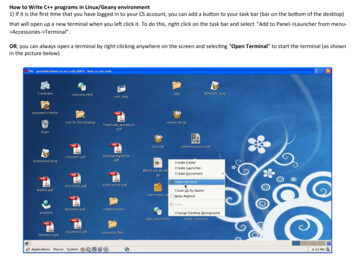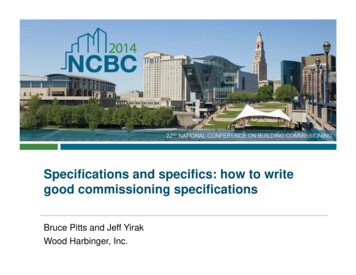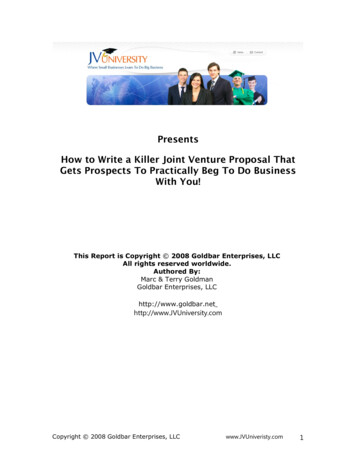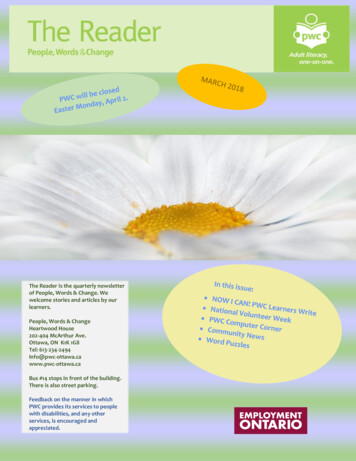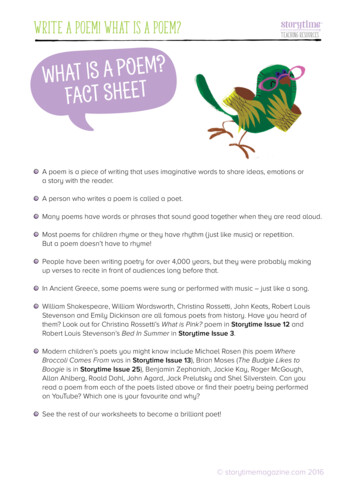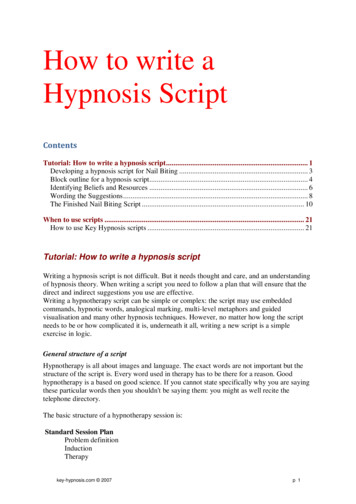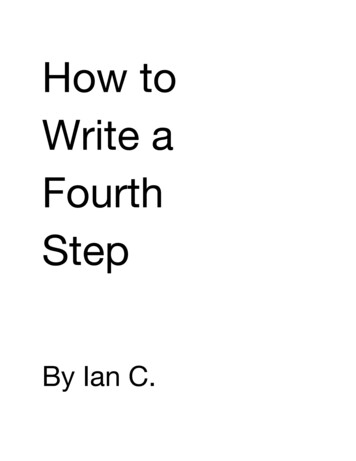
Transcription
How toWrite aFourthStepBy Ian C.
How to Write a Fourth Step by Ian C. (021816)Copies available on Amazon.comReprint freely
Over many years the twelve step program of recovery has expanded its influence.Originally intended to help alcoholics, 12-step recovery has broadened its application toaddress many other addictions and phenomena. In fact, the book Alcoholics Anonymousindicates that the way of life it describes offers benefits for all.
1. Table of Contents1. Table of Contents2. Introduction3. Fourth Step Overview3.1. Notes3.2. Getting Ready4. Resentment Inventory4.1. Making the List4.1.1. People4.1.2. Institutions4.1.3. Principles4.1.4. Numbering List4.1.5. Example: List4.2. Writing the Cause and Affects4.2.1. The Cause4.2.2. Affects my4.2.3. Example: Cause and Affects4.3. The Resentment Prayer4.4. Writing the Turnarounds4.4.1. Selfish4.4.2. Dishonest4.4.3. Self-seeking4.4.4. Frightened4.4.5. Example: Turnarounds5. Fear Inventory5.1. Making the List5.2. Writing the Fears5.3. Example: Fear Inventory6. Sex Inventory6.1. Making the List6.2. Written Work6.3. Example: Sex Inventory6.4. Sane & Sound Sex Ideal7. Step Five Reading7.1. Prepared for Reading7.2. Sharing Step Five7.3. Example Reading Layout for Cause and Affects8. Step Eight Amends List9. Step Ten Inventory9.1. Example: 10th Step Resentment Inventory10. Helping Others
2. IntroductionHow to Write a Fourth Step is a supplemental guide to the fourth step instructions found inthe book Alcoholics Anonymous (the Big Book)1 .It is designed for all people involved in any 12-step recovery program including newcomers,others who may be unsatisfied with the quality of their recovery, and any sponsor wishing tobe helpful.Step four itself is a key milestone in recovery, while steps 5, 8, 9, 10, and 12 additionally relydirectly upon the successful completion of a fourth step inventory. tep 5:SStep 8:Step 9:Step 10:Step 12: We read our inventory to a trusted person in step 5.Step four provides the core of our eighth step amends list.This amends list allows us to make amends in step 9.We continue our inventory process in step 10.We transmit our experience and understanding to others in step 12.Although each personal inventory is unique, the process, concepts, and templates arecommon to all.This guidebook provides clear examples on how to write an efficient and complete fourthstep inventory to help ensure quality sobriety and the clarity to then be helpful to others.1This guide is not conference approved literature nor is it meant to replace any part of the the Big Book. It is based on my personal experience with recovery and only discusses thosesteps which rely directly upon step four. Of course all 12 steps are vital and should beworked with a sponsor whenever possible.
3. Fourth Step Overview3.1. Notes We regularly ask for God’s help during this process. Having completed steps one, two, and three, we are open to God’s help. God provides the strength to move steadily through this work.Inventory helps us rely on God. It reveals that we can’t live successfully based on our finite selves. Inventory does not provide mastery and self-management of thoughts,feelings, and actions - remember, self-knowledge avails us nothing. Ultimately we are not able to wish away our character defects any more thanwe can our disease or dysfunction, even when we understand them. We therefore need and turn to God - this is the ultimate purpose of step 4.It’s recommended we work with a sponsor. This allows us to discuss our progress, experience, and any questions whichmay arise.Step four is a fact-finding process. We are not indulging feelings, purging emotions, or writing a novel. We simply review our lives within the inventory templates as they aredesigned.We hand write inventory. We learn how to organize inventory in notebooks while handwriting step four.We can then pass this experience on to others. Using a computer is not recommended. (This removes the possibility of losingthe entire body of work due to unexpected equipment failure, or unwantedintrusion, etc.) The simple hand-written practice in step four helps us continue writteninventory in step ten. Writing on only one side of the pages makes the work more legible when weread the material in step 5 or share samples in step 12.Step four typically takes from six months to a year to complete. This estimate depends on our dedication and the extent of our inventory; thedepth of our handicaps, and our quantity of experience.Step four is a finite endeavor. A successful fourth step never needs to be repeated. Maintenance inventory in step ten is spread out over time and is lighter thanthe one-time writing investment in step four.No right answers. All inventories are unique, however, the templates and concepts are commonto all.
3.2. Getting ReadyWhen we are ready to begin, we acquire: 5-10 separate single-subject spiral notebooks, college ruled.A few black pens.A quiet place to work.An hour a day (suggested).The fourth step inventory is comprised of three inventories:1. The resentment inventory.2. The fear inventory.3. The sex inventory.
4. Resentment InventoryThe resentment inventory requires three passes:1. Making the list.2. Writing the cause and affects.3. Writing the turnarounds.
4.1. Making the ListIn listing names: Prepare the notebook(s). We take one of our fresh notebooks and write “Cause and Affects - Book 1”on the cover. This notebook will include both our list of names and our causeand affects. We may need more than one spiral notebook for our cause and affects. If so,we label the second book “Cause and Affects - Book 2”, etc. We draw a vertical line down the center of the first page and any consecutivepages needed to complete our list. This allows two columns of names on eachpage. For the principles list we omit the divider line as the “names” are typically a bitlonger.We ask God for the list.Real or imagined. We add names whether the offense was real or imagined.Angry then or now. We add names that we are angry with now or were angry with in the past(even if the anger is not still active).At this point we are only writing down names, we are not yet writing why we wereangry.
4.1.1. PeopleWe start with people. List “People” At the top of the first page, we write “People” and circle it.We get quiet and ask God to provide the list.Relax We don’t stress over forcing people or situations to come to mind. If we don’t remember an offense, we move on. Remember, we are only listingnames at this point (not the reason why we were angry).Scan over our lives. Starting as far back as we can remember, we move forward one year (orphase) at a time until we reach the present. If we finish one session by getting up to the fifth grade for example, we knowwhere to pick the next time we sit down to continue.Types of names: We describe people if we can’t remember their names: “kid with orange bike ingrade 2”, or “blonde girl in grade 5”, or “manager at Acme restaurant”, etc. We can include groups of people: “the Smith family”, “the tennis team”, or“sales staff at cable company”, etc.Number of names: It’s common to have between 50-300 people listed, but of course it could beany number.Leave a blank page for add-ons. When we’re done with our people list, we leave a blank page for any peopleadd-ons while working on institutions and principles.
4.1.2. InstitutionsWhen we’re done with people, we move on to institutions. List “Institutions” Remember, leave one blank page for any people add-ons. Write “Institutions” on top of a new page and circle it.We get quiet and ask God to provide the list.Scan over our lives. Just like we did with people, we review our lives from beginning to presentconsidering all the organizations and institutions with which we had been (orstill are) angry.Relax: Having invited God into this process, we relax and just list the names as theycome to us - not avoiding any names, nor struggling to rack our brains - justsmoothly listing the entities as they come to us.Types of names: We list schools, teams, clubs, churches, religions, employers, businesses,corporations, industries, media outlets, governmental organizations, countries,collection agencies, hospitals, jails, gangs, etc. We list them either specifically or in general, as the case may be.Number of names: Often people have between 25-100 names listed for institutions. But asalways, this can vary widely.Leave a blank page for add-ons. When we’re done with institutions, we leave a blank page for any institutionsadd-ons while we move on to the principles list.
4.1.3. PrinciplesWhen we’re done with institutions, we move on to principles. List “Principles” Remember, leave one blank page for institutions add-ons. Write “Principles” on top of a new page and circle it.We get quiet and ask God to provide the list.Scan over our lives. Just like we did with institutions, we review our lives from beginning to presentconsidering all the principles with which we had been (or still are) angry.Relax: As with the other lists, we invite God into the process. We relax and list theideas as they come to us - not struggling to rack our brains. Just smoothlylisting them as they surface. This section can be a bit challenging and requires some patience.Types of names: Principles can be a bit confusing to identify. Think of them as socialexpectations, social beliefs, ethics, rules, sayings, etc. Examples: “live and let live”, “forgive frequently”, “men should pay”, “womenshould doll themselves up”, “lying/stealing/cheating is wrong”, “pull yourselfup by your bootstraps”, “rich/attractive people are more important than poorpeople”, “poor people are freeloaders”, “we get what we deserve”, “let go, letGod”, “better to give than receive”, “the sky's the limit”, “the glass is halffull/empty”, “actions speak louder than words”, “loners are losers”, “reputationis everything”, “sex outside of marriage is sinful”, “only the strong survive”,“the ends justify the means”, etc.Number of names: A principles list often has between 25-100 items. Although, this too can varywidely.
4.1.4. Numbering ListWhen finished: List any add-on names. We reflect and ask God to show us any further names to add to our people,institutions, and principles lists.Number the names on all three lists. When we feel our lists are complete, we consecutively number all the items onour combined lists. We start at the first person in the “people” list and number straight through tothe last principle. For example if our last person is number 203, then we number our firstinstitution as number 204. And, if our last institution is number 247, then wemake our first principle number 248.
4.1.5. Example: ListPeople(1) Joe(2) Sam(3) Sue(4) Bully on kickball team(5) Jill (202) Sales staff at Acme company(203) FredInstitutions(204) Acme elementary school(205) Anytown city government(206) Anytown police department(207) Acme corporation (245) Alcoholics Anonymous(246) This/that political party(247) Acme newspaperPrinciples(248) Pull yourself up by your bootstraps(249) Ask for help(250) Chivalry(251) Competition is good(252) Embrace change (301) Tell the truth(302) An eye for an eyeNote: Numbering the items allows us to correspond the cause and affects with theirassociated turnarounds in a later notebook.
4.2. Writing the Cause and Affects Review the Big Book example. The Big Book provides an example of how to write and organize both “thecause ” and the “ affects my ” sections. Note how concise the examples are in the Big Book.Prepare the notebook(s). In the same notebook as our list of names, skip a page and then divide thenext page, with vertical lines, into the first quarter, the middle half, and the lastquarter. (The middle section is bigger.)In this section we list: The name of the entity we resent. (First column) Why we have been angry; what did they do (or not do)?. (Second column) Which of our instincts were threatened. (Third column) And indicate that there is fear related to these resentments. (Third column)
4.2.1. The Cause Be concise. Remember how concise the examples are in the Big Book. We are not writing a novel, but rather documenting our fact-finding process. Again, inventory is not meant to provide self-knowledge. Rather, inventoryprovides the willingness to move from self-reliance to God-reliance once wesee the shortcomings of a life based on self-will.Why were we angry. We list the reasons why we have been angry with each person on our list.
4.2.2. Affects myThere are 7 instincts mentioned in the Big Book:1.2.3.4.5.6.7.Pride: What I think others think of me.Self-esteem: What I think of myself.Personal Relations: My relationships with other people.Sex Relations: My intimate relations. (Romantic, sexual. Real or imagined.)Ambitions: What I want in my future.Pocketbook: My financial resources and other assets.Security: My sense of safety.Note: These instincts are healthy when properly balanced, but when we feel they arethreatened we can become excited, indulge in negativity, and respond poorly. List threatened instincts. We list the instincts (from the 7 listed above) that we feel are threatened foreach name on our list.Indicate fear. Fear is not an instinct - instead fear is placed in parentheses (or circled)alongside our threatened instincts for each name on our list. When our instincts are threatened, we often get scared, which can then fuelour resentments. Indicating “fear” prepares us to look at our fears in the turnarounds section ofthe resentment inventory and then again further on in the fear inventory.
4.2.3. Example: Cause and Affects(#) NameThe causeAffects my(1) JoeStole my bike. Lied to my family. Gossiped aboutme.Security,pocketbook,self-esteem, pride(fear)(2) SamHe’s rich and popular. Never paid me back. Madefun of me in front of others.Pocketbook,self-esteem, pride(fear)(3) SueLikes Sam. Won’t talk to me.Sex relations,ambitions,self-esteem, pride(fear)The Big Book shows two basic approaches to writing cause and affects.1. One method, illustrated by the Mr. Brown example, shows the listing out(indenting) of 3 distinct resentment items, each of which have their own list ofaffected instincts to their right.2. A different type of example is seen in the “My wife” example, further down on thatsame page, which clumps all the resentment items together and then lists all theaffected instincts together in the “affects my” column.I find that the later example, the “My wife” method, works efficiently and is shown in theexamples above.When we have worked through our entire list of people, institutions, and principles, we havethen completed the cause and affects and are ready to move on to the turnarounds but firstlet’s look at the resentment prayer.
4.3. The Resentment PrayerAs we arrive at each name while writing the turnarounds we pray the following (as indicatedin the Big Book):“God, help me realize that this person (or institution, or idea) is perhaps spiritually sick.Though I don’t like their symptoms, they may be sick just like I have been. Please helpme show them the same tolerance, pity, and patience that I would cheerfully grant asick friend. How can I be helpful to them? Please save me from being angry. Thy will bedone.”
4.4. Writing the TurnaroundsPrepare the notebook(s). We start a fresh notebook and label it “Turnarounds - Book 1”. If additional notebooks are needed we label them ”Turnarounds - Book 2”, etc. We place our “Cause and Affects - Book 1” on our left and open to ournames-list. We place our new “Turnarounds - Book 1” notebook on our right.Recite the resentment prayer. With the first name in mind, we state the resentment prayer as indicatedabove. We continue this for each name on our list as we come to them.Answer the turnaround questions. For each name on our list, we write the answers the following turnaroundquestions (in our new turnarounds notebook): Where was I selfish?Where was I dishonest?Where was I self-seeking?Where was I frightened?By writing ALL of our outward behaviors in the self-seeking question of theturnarounds, we can then use that section as our core 8th step amends list.Remember, we make amends for our behaviors and omissions ofresponsibilities, not our thoughts.
4.4.1. SelfishWe answer this question: Where was I selfish? Selfish thinking. We write down how our thinking was overly focused on ourselves to thedisregard, disrespect, and detriment of other people.Save behaviors for self-seeking section. We save any selfish behaviors for the self-seeking section of our turnaroundsbecause those outward behaviors will be part of our amends list.Templates for the selfish question: “I was more concerned about getting what I wanted and disregarded them (inthis way - fill in the blank).” Example: I was more concerned about getting attention through gossipingabout others and sarcasm that I disregarded their standing and reputation inthe community. “I wished them harm instead of praying for them, forgiving them, and turningthem over to God.”
4.4.2. DishonestWe answer this question: Where was I dishonest? Self-deception. We write down our self-deception; the lies we tell ourselves.Save behaviors for the self-seeking section. Again, we save any dishonest behaviors for the self-seeking section of ourturnarounds because those outward behaviors will be part of our amends list.Templates for the dishonest question: “I told myself (state the unfounded assumption or belief here) when actually(state what is closer to the truth here).” Example: I told myself that their opinion and treatment of me indicated myvalue, when actually God loves and values me unconditionally. I told myself that they deserved negative consequences when actually it is notmy place to judge and condemn God’s children. I told myself that they are unimportant, when actually God values all of usequally.
4.4.3. Self-seekingWe answer this question: Where was I self-seeking? List behaviors. This is the key section where we list all of our outward behaviors . This allows us to have a one-stop location for our core amends list in step 8.List offenses. Any stealing, cheating, and lying - even though these are dishonest behaviors,we place them here for our amends list. Any of our physical or verbal behaviors of retaliation, cruelty,gossip/character-assassination, etc. toward others. Any omissions of our responsibilities as a child, parent, friend, partner,employee / employer, citizen, etc.
4.4.4. FrightenedWe answer this question: Where was I frightened? List fears. This is where we indicate fears we have that are related to the name arewriting about.Template for the frightened question: “I was/am afraid that ”. Example: “I was afraid that if I remained quiet that I would just blend in andnobody would ever notice me, that I would be left behind.”
4.4.5. Example: Turnarounds(#) NameTurnarounds(1) JoeSelfish (S): I wanted to parade around with my new bike so that theneighborhood would think I was really special. I have resented him fordecades instead of keeping it in context and praying for him.Dishonest (D): I told myself that he gossiped about me, when I don’tknow that for sure.Self-seeking (SS): I gossiped about him every chance I got. I damagedhis bike in retaliation.Frightened (F): That my possessions aren’t safe. That I’m unworthy ofrespect. That everyone wants to make fun of me and undermine me.(2) SamS: I only wanted good things to happen to me. I didn’t want anyone to bemore comfortable or happier than me. I wished him harm instead ofseeing him as a child of God.D: I told myself that if I wasn’t receiving the gifts that others wereexperiencing that God must not love me, when actually God loves us allequally and I was blocking my own happiness in life. I convenientlydisregarded the fact that I had told Sam that he didn’t have to pay meback.SS: My negativity and self-pity has kept me from being present for Godand others. I told people that Sam was a cheapskate.F: That I’m unworthy of friends, comfort, and God’s blessings.(3) SueS: I didn’t want her to like anyone but me. I expected her to know Iwanted to be her boyfriend.D: I told myself that I was unattractive because Sue didn’t pay attentionto me, when actually as God’s creation I am beautiful and loved. I toldmyself Sue wouldn’t talk to me, when actually I never even tried to start aconversation with her.SS: I made up lies about her to my friends and used mean names whentalking about her. I indulged in negativity and remained unavailable forGod and others.F: That I’m unattractive and unworthy of love.
5. Fear InventoryThe fear inventory requires two passes:1. Making the list.2. Writing the fears.
5.1. Making the List Prepare our notebooks. We take our our notebook titled “Turnarounds - Book 1” and place it in front ofus on our left. We take out another fresh notebook and write “Fear Inventory” on the cover we place this notebook in front of us to the right.Fears from our turnarounds. We go through the frightened section of our turnarounds (the notebook on ourleft) and transfer all those fears into a draft-list fears in our new “FearInventory” notebook on our right. Then we go back through our draft-list (making a new, clean list) consolidatingany redundant fears so that we have gleaned a complete list of unique fears. We do this with all our our turnarounds notebooks (if we have more than one).Add fears not connected with resentments. Next, we add on any other fears which did not have any resentmentsconnected to them. Examples: “snakes”, “wild animals”, “car crashes”, “epidemics”, “tornadoes”,“unexpected events”, etc.
5.2. Writing the Fears Skip a page. We skip a page after our fear list in our “Fear Inventory” notebook and answerthe following questions for each item in our fear list:“Fear:” We write down the first fear indicated on our list.“Why:” We write down our first experience of that fear and any other major experienceof that fear in our lives.“Self-reliance fails:” We write how we attempted to manage this fear and the result of theseattempts (based on our finite selves) have failed us. [Note: Self-reliance alwaysfails if we look deeply enough.] Example: “I tried to be everyone’s friend, doing everything I could for them sothat they would all like me, the result was that people found me fakey andirritating, I became exhausted, and even more depressed.”“Trusting and relying on God.” We write “Trusting and relying on infinite loving God would allow meto (fill in the blank) .” We fill in the blank with what we imagine God could do for us in the context ofremoving that fear; what we could experience if we were filled with courageand love. Example: “Trusting and relying on infinite loving God would allow me to relax. Iwould know that everything happens for the best in God’s time, even if I mightnot understand. I would be patient with John Doe and not take his behaviorpersonally.”“God please remove my fear ” Lastly, we write “ God, please remove my fear of. (fill in the blank here withby listing the fear again) .and turn my attention to what you would have mebe. ” This is a prayer and is written and read in that spirit.
5.3. Example: Fear InventoryFear: That my possessions aren’t safe.Why: My bike was stolen when I was in grade school. My car was broken into a few yearsago.Self-reliance fails: Sometimes I didn’t buy nice things because I’ve been afraid they willget stolen, the result was I remained in fear and didn’t get the enjoyment of qualityproducts. I didn’t have people over to visit so that they wouldn’t know what I own, theresult was that this severely limited my social life.Trusting and relying on infinite loving God would allow me to: relax. I would know thatwhatever God wants me to have, enjoy, and share will be provided for me throughreasonable efforts. I could comfortably acquire quality belongings, enjoying them andsharing them in a reasonable and thoughtful manner. I would take reasonable steps tosecure my belongings. I would not suffer from worry or paranoia over my belongings beingdamaged or stolen - this would allow me to be present in my life, for God, and others.God, please remove my fear that my possessions aren’t safe and turn my attention to what you would have me be.----------------Fear: That I’m unworthy of respect.Why: Kids made fun of me on the playground. I spent time in jail.Self-reliance fails: I have made fun of other people in retribution, the result was that thisdamaged my social life. I tried to act more important than others, the result was that thisfeeling was short-lived and left me depressed - also people found me arrogant andavoided me. I pretended I didn’t care what other people thought of me, the result was thatinside I was actually still obsessed about getting people to think highly of me and then Ilost touch with my own feelings.Trusting and relying on infinite loving God would allow me to: relax. I would get mysense of dignity directly from the love of God. My self-respect would be independent ofwhat people thought of me. With this confidence, I could move forward in my life,engaging with other people comfortably and respectfully.God, please remove my fear that I’m unworthy of respect and turn my attention to what you would have me be.
6. Sex InventoryThe sex inventory is the last part in the inventory process. Ask for God’s help. We ask God to be with us in this work.Focus on manipulation to get sex. Although it is possible that information about specific sex acts may enter intothe writing of the sex inventory, the vast majority of the writing in this section isabout how we thought and behaved in selfish ways as we attempted tomanipulate other people around us.Further additions to 8th step amends list. Note: When we arrive at step 8, we will not only take from the “self-seeking”portion of the resentment inventory turnarounds section, but also from this sexinventory where offensive behaviors may show up in answers to the variousquestions.
6.1. Making the List Prepare the notebook(s). We take out a fresh notebook and title it “Sex Inventory”.Make a list. We start out the sex inventory by making a list of names. These include people from our past and present. People with whom we had sexual, romantic, or intimate experiences. It also can include people whom we were obsessive in our imagination. Our list can include items like pornography, prostitution, bath houses, etc. If we can’t remember a person’s name, we can use a descriptor, such as“one-night stand at acme bar”, etc.
6.2. Written WorkOnce we have our list, we answer the following nine questions for each name on our list: Where was I selfish?: We look for where we were we focused on ourselves to thedetriment of other(s). Where was I dishonest?: We look for where we failed to keep our commitments,where did we lie, misrepresent, or exaggerate, etc. Where was I inconsiderate?: We look for where we failed to consider our affect onother people or failed in our responsibilities. Whom had I hurt?: This can include the person with whom we may have sharedintimacy and other affected people: family, friends, other partners, etc. Where did I unjustifiably arouse jealousy?: We look for where we intentionally orcarelessly caused another person to experience jealousy? Maybe we intentionallycaused jealousy in an attempt to manipulate someone’s perception of us. Where did I unjustifiably arouse suspicion?: We look for where we intentionally orcarelessly caused another person to experience suspicion? Maybe we intentionallycaused suspicion to gain attention. Where did I unjustifiably arouse bitterness?: We look for where we intentionally orcarelessly caused another person to experience bitterness? Maybe we intentionallycaused bitterness as a form of retribution or to feel powerful. Where was I at fault?: For this question we add any other offenses and harm wecreated beyond what has been answered in the previous questions. What should I have done instead?: With the principles of kindness, love, tolerance,and honesty in mind, we write down what would have been appropriate behavior.
6.3. Example: Sex InventoryName: Jane Doe (affair)Where was I selfish?: I wanted immediate pleasure without caring how others might beaffected. I wanted my friends to be impressed that I took her home.Where was I dishonest?: I had previously promised to my partner that I would be faithfulbut I broke that promise. I told myself that if my partner didn’t find out, that it didn’t matter,when actually I needed to honor my commitments regardless of who was aware of mybehavior.Where was I inconsiderate?: I didn’t discuss safe sex or use protection, thus risking thepossibility of bringing a communicative disease back to my partner. I didn’t consider thatJane Doe might get pregnant - I assumed if she did, that she would get an abortion.Whom had I hurt?: My flagrant disregard for Jane Doe’s wellbeing and dignity hurt her. Idamaged the quality of my relationship with my partner. I risked the health of Jane Doe,my partner, and myself. I affected my partner’s relationships with her friends and familywhen we eventually broke up over this act of infidelity. I let down people who had formerlyseen me as a role model.Where did I unjustifiably arouse jealousy?: When I ran into Jane Doe at the grocerystore (with my partner) I flirted and laughed with Jane Doe, thinking that my partner wouldsee me as more desirable.Where did I unjustifiably arouse suspicion?: By acting macho in front of my friendswhen I took Jane Doe home, they started to call me “the charmer” in front of my partner my partner asked me why they had started to call me that name.Where did I unjustifiably arouse bitterness?: I caused hurt and
How to Write a Fourth Step is a supplemental guide to the fourth step instructions found in the book Alcoholics Anonymous (the Big Book)1. It is designed for all people involved in any 12-step recovery program including newcomers, others who may be unsatisfied with the quality
